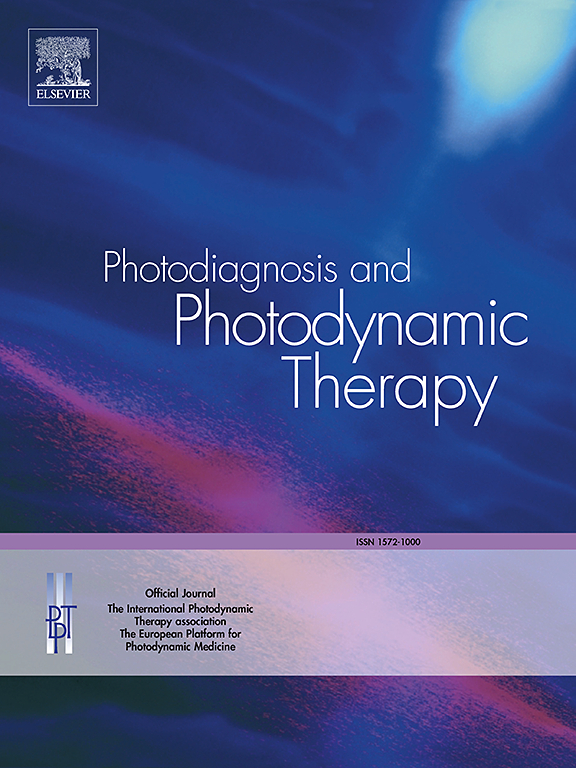光动力疗法光":通过将激光辅助低辐照度光动力疗法与缩短日光光动力疗法相结合,改进了光化性角化病的治疗方案,使疼痛最小,临床疗效最佳。
IF 3.1
3区 医学
Q2 ONCOLOGY
引用次数: 0
摘要
背景:2003 年至 2016 年间,我们诊所有 546 名患者因无法忍受疼痛而中断了使用传统光动力疗法(PDT)对光化性角化病(AKs)的门诊治疗,因此有必要使用一种痛苦较小的治疗方法。因此,我们开发了一种新颖的标签外光动力疗法方案--"光动力疗法光":方法:方法:从 2014 年开始进行激光辅助低辐照度 PDT(li-PDT)治疗。2018年,剂量逐渐降低到8-12 J/cm²,这样我们在保持相当疗效的同时,疼痛也大大减轻了。从2018年起,通过将li-PDT的优势与日光PDT(DLPDT)相结合,进一步显著减轻了疼痛,从而在2018年形成了新技术 "光PDT"。AK奥尔森1级或2级和视野癌化的患者首先接受轻度分次CO2激光预处理,然后在闭塞状态下进行1.5-3小时的MAL-孵育(氨基乙酰乙酸甲酯,Metvix ®)。然后,用Aktilite-LED对患者进行平均1.02分钟的照射,并在照射区域涂上紫外线屏后,将患者送出日光下照射1小时:在 2019 年 3 月至 11 月期间,我们使用增强型 "PDT 光 "程序成功治疗了 152 例患者,其中 137 例患者在随访 1 期(平均 8.14 个月后)达到良好至卓越的清除率(CLA 和 CLB 合计 90%),不良反应极少:新颖的 "PDT 光 "方案被证明是一种出色且几乎无痛的方法,平均视觉模拟量表(VAS)评分为 1.19。与单独使用 DLPDT 相比,该疗法还具有照明时间短、门诊停留时间短、不良反应少、患者依从性好等优点。本文章由计算机程序翻译,如有差异,请以英文原文为准。
‘Photodynamic therapy light’: An enhanced treatment protocol for actinic keratoses with minimal pain and optimal clinical outcome by combining laser-assisted low irradiance PDT with shortened daylight PDT
Background
Between 2003 and 2016, 546 patients in our clinic discontinued outpatient treatment for actinic keratoses (AKs) using conventional photodynamic therapy (PDT) because of intolerable pain, thereby necessitating the use of a less painful procedure. Therefore, we developed a novel off-label PDT protocol: ‘PDT light’.
Methods
Laser-assisted low irradiance PDT (li-PDT) was performed beginning in 2014. The dosage was gradually lowered to 8–12 J/cm² in 2018, so that we achieved considerable pain reduction while maintaining comparable therapeutic efficacy. A further considerable reduction in pain was achieved from 2018 onwards by combining the advantages of li-PDT with daylight PDT (DLPDT), thereby resulting in 2018 in the new technique ‘PDT light’. Patients with AK Olsen grades 1 or 2 and field cancerization initially received a mild-fractionated CO2 laser pretreatment prior to MAL-incubation (methyl aminolaevulinate, Metvix ®) under occlusion for 1.5–3 h. Then, patients were illuminated on average for 1.02 min with the Aktilite-LED and, after application of an UV-screen on the illuminated area, sent out into daylight for 1 h.
Results
Between March and November 2019, we successfully treated 152 cases using the enhanced ‘PDT light’ procedure, with 137 cases achieving at follow-up 1 (on average after 8.14 months) good-to-excellent clearance rates (CLA and CLB together 90 %) and minimal adverse effects.
Conclusions
The novel ‘PDT light’ protocol proved to be an excellent and nearly painless method with an average visual-analogue scale (VAS) score of 1.19. Additional advantages included reduced illumination time, shorter outpatient stays in the clinic, fewer adverse effects, and better patient compliance than with DLPDT alone.
求助全文
通过发布文献求助,成功后即可免费获取论文全文。
去求助
来源期刊

Photodiagnosis and Photodynamic Therapy
ONCOLOGY-
CiteScore
5.80
自引率
24.20%
发文量
509
审稿时长
50 days
期刊介绍:
Photodiagnosis and Photodynamic Therapy is an international journal for the dissemination of scientific knowledge and clinical developments of Photodiagnosis and Photodynamic Therapy in all medical specialties. The journal publishes original articles, review articles, case presentations, "how-to-do-it" articles, Letters to the Editor, short communications and relevant images with short descriptions. All submitted material is subject to a strict peer-review process.
 求助内容:
求助内容: 应助结果提醒方式:
应助结果提醒方式:


